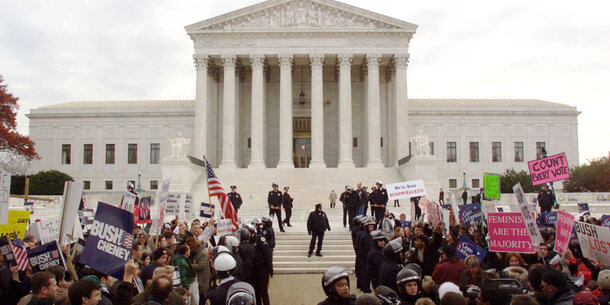You’re reading The Briefing, Michael Waldman’s weekly newsletter. Click here to receive it every week in your inbox.
Donald Trump’s legal hot water continues to heat up. Special counsel Jack Smith sent a target letter to the former president last week, and an indictment could come within days. We don’t yet know Smith’s full theory of the case, but the statutes he is reportedly considering open the possibility of a broad prosecution that could go beyond the events of January 6. The insurrection was not an isolated moment of political violence but a last throw of the dice in Trump’s monthslong conspiracy to disrupt the peaceful transfer of power. The prosecution should recognize that fact.
Smith has reportedly notified Trump that he could be charged under three statutes. The most widely anticipated of the charges is for obstructing an official proceeding — Congress’s certification of the 2020 election results on January 6. A second charge, attempting to defraud the United States, likely relates to Trump’s collection of fake elector certificates, which he pressed Vice President Mike Pence to adopt in order to subvert the Electoral College.
These charges both relate directly to the events of January 6. But the third charge could go further. Smith reportedly will accuse Trump of violating Section 241 of Title 18 of the U.S. Code, which makes it a crime to “conspire to injure, oppress, threaten, or intimidate any person . . . in the free exercise or enjoyment of any right or privilege secured to him by the Constitution or laws of the United States.”
The provision, originally part of the Ku Klux Klan Acts of the Reconstruction era, aimed to protect Black voters from intimidation and physical violence. The KKK’s power has faded since then, but the law remains a vital safeguard against all forms of election subversion, as my colleague Sean Morales-Doyle explains. It has been used to prosecute public officials who attempted to omit valid ballots from a vote count as well as private actors who sought to coerce or bribe voters. Just this year, a Twitter user who gave deliberately false voting instructions to divert votes from Hillary Clinton in 2016 was convicted under Section 241.
Fundamentally, Section 241 prohibits any attempt to prevent, alter, dilute, or nullify a vote. How did Trump conspire to do so? Let us count the ways.
He contacted the speaker of the Pennsylvania House of Representatives, seeking help in overturning the state’s electoral results. He called county canvassing board officials in Michigan, after which the officials attempted to rescind their certification of the vote. Most infamously, he called Georgia Secretary of State Brad Raffensperger, urging him to “find 11,780 votes,” enough to reverse Joe Biden’s win in the state.
Trump tried to weaponize the court system, filing a slew of bogus lawsuits to stop the counting and certification of votes. These lawsuits were based on conspiracy theories and disinformation, in at least one case leading to court-ordered sanctions against his attorneys. (Will these frivolous lawsuits be included in the charges? That’s hard to say, for constitutional reasons. But as a matter of fact if not law, they were part of the effort to undo the legitimate election results.)
Trump’s spokespeople and allies in the media lied relentlessly about both the voting machines and the actual human beings tasked with counting the votes. The lies were so shameless that Fox News agreed to pay a whopping settlement rather than having to defend them in court.
And, finally, Trump’s associates contacted leaders of white supremacist groups to help bring armed and deluded goons to Washington, where Trump urged them to “fight like hell.”
All of this happened before House Speaker Nancy Pelosi banged the gavel on January 6 to begin the certification of the 2020 election.
Insurrections aren’t built in a day. January 6 was the result of months of planning by a band of election saboteurs, with Trump at its center.



